Karplakastan is a region in Northwest Uzbekistan which has had a really bad century. The entire region’s climate and economy has been greatly affected by The USSR’s draining of the Aral Sea in the 1960’s. What was once the world’s fourth largest lake has been drained to irrigate the cotton fields throughout Central Asia. Moynaq, formerly one of two major fishing ports on the sea, is now a desolate, dusty town 150 km from the sea with little employment and little hope.
I flew into Nukus, the region’s capital, two days ago to start my travels around Uzbekistan. Because I plan to enter Tajikistan near Samarkand I decided to start from the far end of the country and make my way back East overland. I checked in early and was given a handwritten cardboard boarding pass from a stack a few inches thick. When I requested a window seat the woman shrugged and motioned that she hands them out in the order they are in the stack. One enormous man checked in and I assumed he would be seated next to me, since that seems to be my luck on this trip. While I waited to board I watched passengers carry huge boxes or plastic bags of heavy-looking goods toward the check-in desk. As far as I could tell nothing was being weighed and in addition to the enormous man I figured that we would never make it off the ground. The guard working the x-ray machine made me feel a bit better about the flight when he actually wanted to look in my bag and questioned what some of my hand luggage was. This is the first time anyone has taken a second glance at my bag on this trip, which holds all of my electronics and delicate items during flights. This includes my laptop, iPod, hard drive, SLR, compact camera, extra lens and two disposable cameras. This bag should have been questioned a long time ago, especially in Uzbekistan.
The flight turned out fine once I figured out that there were no assigned seats, contrary to what my boarding pass said, and the stewardess took pity on me and made an Uzbek businessman give me the aisle seat. We were given one roll and packets of jam and cream cheese for our meal and I read the remaining articles in the in-flight magazine I hadn’t read on the way into the country, including one on Uzbekistan’s love for Bollywood films. We departed onto the runway as the sun set and waited for our bags to be loaded onto the only baggage conveyer in the airport. I was once of the first out and quickly found a driver willing to take me to my hotel for 1500 cym. My first choice turned out to be more expensive than I thought and only had a room for two nights. The way I figured, I would go to the museum the next day and take a taxi to Moynq the following day, returning that night before leaving for Khiva. I couldn’t do that if I could only stay for two nights so I jumped back in the taxi and told him to take me to another place down the road. We seemed to be going really far back toward the airport so I made him turn around and head to another big hotel in town. He decided to take me to another hotel I hadn’t heard of but they appeared to be full. Next we went by the largest hotel in town, but the parking lot was crowded with five massive tour buses. It was no surprise that it was full. He suggested a hotel which my guidebook described as “decrepit” and “run down” so I told him to head back to the original hotel— I would just have to change my plans around a bit.
There were a few issues I had to deal with. Although there is once public bus a day to Moynaq, it leaves at 9am from Nukus and returns from Moynaq at 3pm. That doesn’t give me enough time to take the bus for a day trip but gives me too much time if staying overnight. By all accounts Moynaq was described as “depressing” and “hostile” so I didn’t want to spend too much time there, but I did want to see it. The other option was a taxi, and I hadn’t met any other tourists to share the ride with. Incidentally, although my hotel was going to be full in two days, I was the only guest while I was there so I would have to pay the entire cost myself. I also had to keep the Nukus art museum in mind, which I thought was closed on Sundays. I decided that rushing through a depressing town was better than being stuck and adding even more days to my time in Uzbekistan. Besides the fact that Uzbekistan is much more expensive to travel in that Kyrgyzstan, I have to keep the Pamir weather in mind and need to travel through Tajikistan sooner rather than later.
I found a cafe open past eight for dinner and ordered a cucumber and tomato salad, fried dumplings, Fanta and bread. Apparently that was a lot and the customers in the front of the restaurant were trying to get back to watch me eat but the waitress wouldn’t let them. The bread was actually for desert back at my hotel where I had a jar of chocolate spread and a bottle of yellow mustard I had bought in Bishkek. That night I had my first run in with a tour group, before I realized that Uzbekistan is overflowing with tour groups, mainly French. Although the group wasn’t staying at my hotel they were eating there. I had passed on dinner there (more meat soup, ugh) and when I returned I saw the bus pull up and watched the passengers rush into the courtyard off my room. The last woman actually broke into a jog, which I laughed at until I saw how these groups operate. I walked into the courtyard less than a minute after the group and they were all already eating! I can’t imagine traveling in such a way where I literally get off a bus and step up to a waiting meal. No wonder my hotel’s manager was so stressed out. I took my bread and 1.5 liter bottle of cold Coke (Coke’s almost only sold in 1.5 liter containers in Uzbekistan!) to my room, knowing that the group would finish eating and leave as quickly as they arrived.
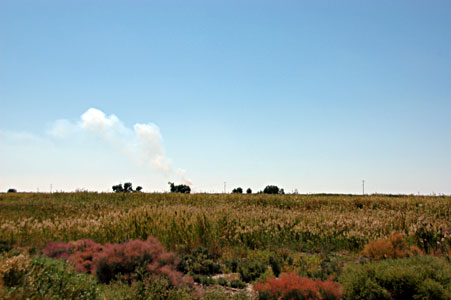
The landscape near Moynaq
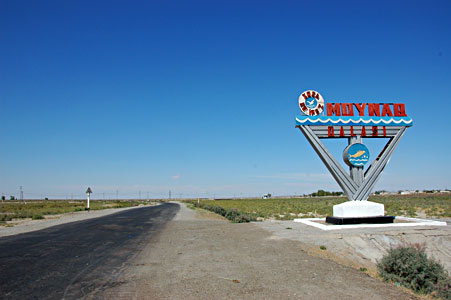
Moynaq’s sign shows it’s fishing history
I set off early the next morning to find a taxi at the bazaar. My hotel offered one for $60 but I was able to bargain a nice new Daewoo Martiz for $40 round trip. The ride was pretty boring and I took a nap in the front seat, which reclined. The ride helped out with my new v-neck shaped tan tine. The road approaching Moynaq was elevated and I saw a few dust tornadoes beside the road. The town’s sign has a fish on it, sadly, and driving into town it seemed like everyone was just standing around the main drag staring off into space. The driver stopped the car and said “photo?” He obviously hadn’t driven to Moynaq before and thought I just wanted to come to town to take a photo. I drew a horrible picture of some boats in sand and he drove a little bit more and found a boat statue in the square. I tried to explain that there were many boats outside of town but he spoke no English and wasn’t keen on my pictoral representation of a boat graveyard.
We drove around a bit and he finally gave in and asked some woman for the boats. They seemed as confused as him and explained that the Aral Sea was 150km away. The driver was mad and told me he didn’t want to drive to the Aral Sea. I tried to get him to drive further but he turned back into town and refused to ask anyone under 30 for directions. I saw a school and told him to pull over and wait—there was no way I was paying $40 to drive to a town and not see the rotting boats. The schoolyard erupted into cheers of “hello, hello, hello” when I walked in. I asked for an English teacher and was pointed to another building where older kids hung out. A group of teenage girls talked to me and had basic English skills. Someone in these Central Asian countries taught everyone that the proper response to “thanks” is “not at all.” I think it sounds a bit silly and old-fashioned and I laugh a little every time someone says it to me.
The bell rang and I was worried that I wasn’t going to find any English speakers until the director came down the hall and introduced himself. He came outside with me and talked to my driver, explaining where I wanted to go. The instructions seemed extremely complicated for no reason and I realized that he was asking about about me and how much I paid. Looking at his watch, the director sighed and said that if he didn’t have a meeting he would take me to the boats and be my guide. Since I am only paying $40 and it’s so cheap he would only charge me maybe $20 for his services. I told him I just needed directions and the man went through another long speech in Russian. One of the problems may have been that the driver was speaking Russian and the locals don’t speak much Russian at all and some don’t even speak Uzbek, they have a local Karaplakastani language.
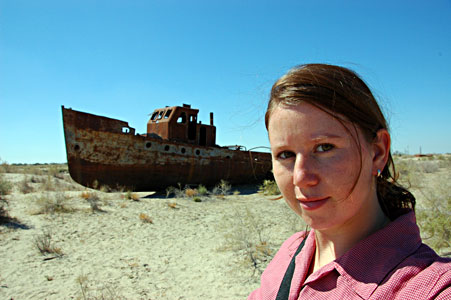
Megan and a rusty boat
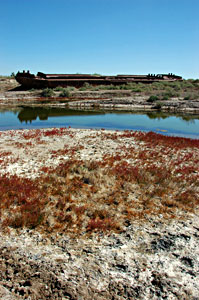
A bit of rain water and salty mush—the great Aral Sea
We found the boats, which were two minutes from the main road at the old port. My driver slept while I walked around taking photos. The early afternoon isn’t the best time for photography but my only choice for nice lighting would have been to stay the night. Some of the lower ground was soft and had a crusty salt coating. I can’t imagine what it was like to have your entire town’s economy dried up in a few years, but it was quite a while ago now and I wonder why people stay. The environmental changes have wrecked havoc on more than the economy, the entire region, including Nukus, has higher rates of cancer not to mention other diseases.
We headed back to Nukus after an hour or so and I was happy to have a nice car for the ride. Along the way people were standing out in the blazing sun waiting for cars to pass and the driver motioned if it was okay to pick them up. I agreed since I had the front seat and figured that if he makes a little extra cash he won’t even think to complain about the price I was paying. The people getting on were so happy and thanking the driver and me that I decided it was good we picked them up, there’s not much traffic on that road. They were probably also happy not to be stuffed in the back of a Lada. We parted happily with a handshake back at the bazaar, which doesn’t happen often. I took a stroll through the stalls, buying a comca (samosa) and taking a few photos. In the fish aisle a woman posed with her fish far away, asking for her photo to be taken. This opened up discussion with her and her friends, who asked where I was from and if I was a journalist. A few minutes later in the covered bazaar a woman came running buy yelling “Americanski, Americanski” to which few people even reacted.
Many people in Uzbekistan carry either bread or empty bottles in old baby carriages, which I find pretty funny. They find it pretty funny when I take photos of them. I am also curious about the drink dispensers they have. All of these countries have stands on the street selling drinks out of a big container. I don’t taste them because they’re mixed with tap water and served in communal glasses. I saw new drink stands in Uzbekistan though, which hold syrup in a glass container that’s mixed with tap water with gas injected form a canister below the stand. Most people who drink bottled water here drink “sparkling” water with gas, which tastes like skunk to me.
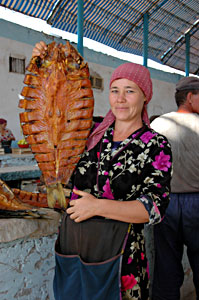
A woman displays her dried fish at the Baazar
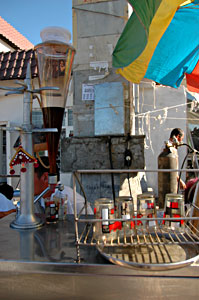
The syrup/gas/water drink stand
The next morning I packed my things and headed for the art museum, which is supposed to have one of the best art collections in the country. The hotel owner told me that I could stay longer because the group had cancelled but I had already changed my plans around. It was a nice hotel, decorated in traditional materials, but not worth the $15 for a room with no bathroom and no opening windows. Even with no opening windows I had to stay up for hours to kill the handful of mosquitoes that got in.
The museum had a students discount, which is only allowed for students under 25. I said I was 25, since I can probably pass for 20 in Central Asia. The only problem was that I didn’t realize my student ID has my birthday on it so I had to finally give in and pay the extra dollar for admission. Once again, math defeats me! The museum was worth it though, with plenty of jewelry, costumes, embroidery and even headdresses. The upper floors had painting, some of which I liked but most of it wasn’t anything special. Outside the museum was a statue of a man with a furry hat in a park with a ferris wheel and a few kid’s rides. Fall is wedding season and the square was swarming with bridal parties. Cars decorated with streamers and dolls tied to the hoods lined the street and groups walked down the sidewalk to the statue while being filmed by a videographer with a massive camera. So many bridal parties were doing the same thing that there was a line of people waiting to pose in front of the statue and then to ride the ferris wheel. All of the brides wore white dress and the men were in suits. They appeared to have a best man and bridesmaid dressed in their finest but the rest of the family was often in t-shirts and everyday clothes. After fifteen minutes of wedding watching I was satisfied with my brief visit to Karplakastan, flagged down a taxi to the bus station and bought a ticket on the next dilapidated bus South to Khiva.
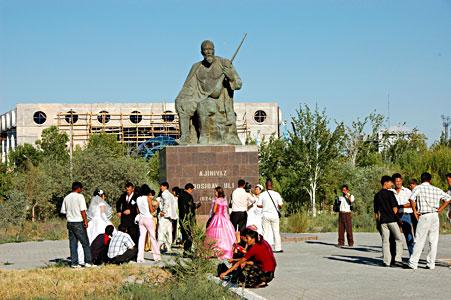
Posing for wedding photos in front of a statue
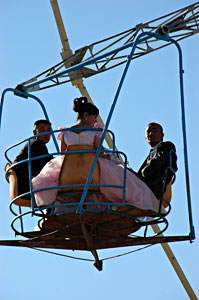
The wedding party on a scary-sounding ferris wheel
3 responses to “The End of the Road”
Love the boat shot!
Hmm, I use “Not at all” all the time. I wonder where I got it…
I think you read too many books as a child, Kate.